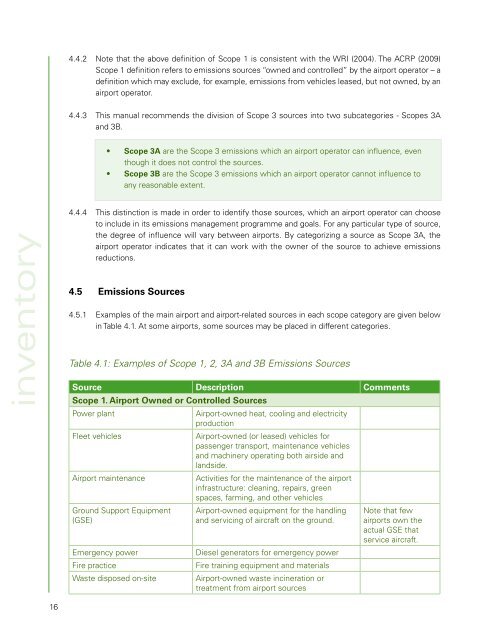Airport Greenhouse Gas Emissions Management - Zurich Airport
Airport Greenhouse Gas Emissions Management - Zurich Airport
Airport Greenhouse Gas Emissions Management - Zurich Airport
Create successful ePaper yourself
Turn your PDF publications into a flip-book with our unique Google optimized e-Paper software.
4.4.2 Note that the above definition of Scope 1 is consistent with the WRI (2004). The ACRP (2009)<br />
Scope 1 definition refers to emissions sources “owned and controlled” by the airport operator – a<br />
definition which may exclude, for example, emissions from vehicles leased, but not owned, by an<br />
airport operator.<br />
4.4.3 This manual recommends the division of Scope 3 sources into two subcategories - Scopes 3A<br />
and 3B.<br />
• Scope 3A are the Scope 3 emissions which an airport operator can influence, even<br />
though it does not control the sources.<br />
• Scope 3B are the Scope 3 emissions which an airport operator cannot influence to<br />
any reasonable extent.<br />
inventory<br />
4.4.4 This distinction is made in order to identify those sources, which an airport operator can choose<br />
to include in its emissions management programme and goals. For any particular type of source,<br />
the degree of influence will vary between airports. By categorizing a source as Scope 3A, the<br />
airport operator indicates that it can work with the owner of the source to achieve emissions<br />
reductions.<br />
4.5 <strong>Emissions</strong> Sources<br />
4.5.1 Examples of the main airport and airport-related sources in each scope category are given below<br />
in Table 4.1. At some airports, some sources may be placed in different categories.<br />
Table 4.1: Examples of Scope 1, 2, 3A and 3B <strong>Emissions</strong> Sources<br />
Source Description Comments<br />
Scope 1. <strong>Airport</strong> Owned or Controlled Sources<br />
Power plant<br />
Fleet vehicles<br />
<strong>Airport</strong> maintenance<br />
Ground Support Equipment<br />
(GSE)<br />
Emergency power<br />
Fire practice<br />
Waste disposed on-site<br />
<strong>Airport</strong>-owned heat, cooling and electricity<br />
production<br />
<strong>Airport</strong>-owned (or leased) vehicles for<br />
passenger transport, maintenance vehicles<br />
and machinery operating both airside and<br />
landside.<br />
Activities for the maintenance of the airport<br />
infrastructure: cleaning, repairs, green<br />
spaces, farming, and other vehicles<br />
<strong>Airport</strong>-owned equipment for the handling<br />
and servicing of aircraft on the ground.<br />
Diesel generators for emergency power<br />
Fire training equipment and materials<br />
<strong>Airport</strong>-owned waste incineration or<br />
treatment from airport sources<br />
Note that few<br />
airports own the<br />
actual GSE that<br />
service aircraft.<br />
16

















